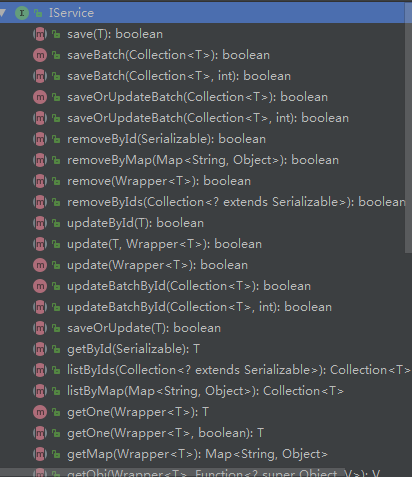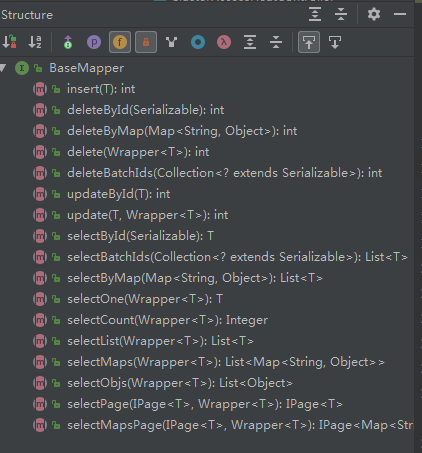一、MyBatis-Plus 主要特性
二、常用的CRUD接口
三、条件构造器
四、MyBatis-Plus 实现表的增删改查操作示例
一、MyBatis-Plus 主要特性
(1) MyBatis-Plus 内置通用的Mapper和Service,还有强大的条件构造器,支撑起强大的CRUD操作
(2)使用Lamdba表达式调用实体类的字段,不需要担心字段名写错
(3)内置代码生成器,采用代码或者 Maven 插件就可以快速生成 Mapper 、 Model 、 Service 、 Controller 层代码
二、常用的CRUD接口
包括Service层和Mapper层的CRUD接口,可查看官网的详细描述
转官网介绍:https://baomidou.com/guide/crud-interface.html#service-crud-%E6%8E%A5%E5%8F%A3
Service层CRUD操作主要是封装在IService接口里,包括get查询单行,list查询集合,remove删除,page分页等。
Service层CRUD操作的这些前缀命名与Mapper层的CRUD操作有所区别,分别对应Mapper层CRUD操作:select查询单行、集合和分页,delete删除,封装在BaseMapper中。
三、条件构造器
MyBatis-Plus提供了Wrapper抽象类,支持很多sql语法,比如查询,比较,分组查询,排序,子查询等,方便我们用面向对象的方式去实现sql语句。
1、条件构造器Wrapper类
Wrapper: 条件构造抽象类,最顶端父类
AbstractWrapper: 用于封装查询条件,生成 Sql 的 Where 条件
QueryWrapper: Entity 对象封装查询操作类
UpdateWrapper: Update 条件封装,用于Entity对象更新操作
AbstractLambdaWrapper: Lambda 语法使用 Wrapper 统一处理解析 Lambda 获取的 Column。
LambdaQueryWrapper:用Lambda语法来使用查询Wrapper
LambdaUpdateWrapper:用Lambda语法来使用更新Wrapper
2、条件构造器和SQL的对应关系
四、MyBatis-Plus 实现表的增删改查操作示例
准备工作:先添加MyBatis-Plus 依赖
org.mybatis.spring.boot
mybatis-spring-boot-starter
${mybatis.spring.boot.starter.version}
com.baomidou
mybatis-plus-generator
3.0.7.1
com.baomidou
mybatis-plus
3.1.2
com.baomidou
mybatis-plus-boot-starter
3.1.1
1、查询操作
(1)单行查询
@Autowired
private SysDeptMapper sysDeptMapper;
@Test
public void selectOne(){
//1-构造LambdaQueryWrapper构造器
LambdaQueryWrapper lambdaQueryWrapper = new LambdaQueryWrapper<>();
//2-查询部门名称=研发部门的记录
lambdaQueryWrapper.eq(SysDept::getDeptName,"研发部门" );
//3-查询一条记录
SysDept sysDept = sysDeptMapper.selectOne(lambdaQueryWrapper);
System.out.println("查询一条记录:"+sysDept);
}
(2)集合查询
@Autowired
private SysDeptMapper sysDeptMapper;
@Test
public void selectList(){
//1-构造LambdaQueryWrapper构造器
LambdaQueryWrapper lambdaQueryWrapper = new LambdaQueryWrapper<>();
//2-查询部门名称like "%部门" 并且部门电话号码不为空
lambdaQueryWrapper.likeLeft(SysDept::getDeptName,"部门" ).isNotNull(SysDept::getPhone);
//3-查询集合
List sysDeptList = sysDeptMapper.selectList(lambdaQueryWrapper);
sysDeptList.forEach(System.out::println);
}
(3)分页查询
@Autowired
private SysDeptMapper sysDeptMapper;
@Test
public void select(){
//1-构造LambdaQueryWrapper构造器
LambdaQueryWrapper lambdaQueryWrapper = new LambdaQueryWrapper<>();
//2- id 降序排列
lambdaQueryWrapper.orderByDesc(SysDept::getDeptId);
//2.1-分页 curpage当前页,pageSize每页条数
Integer curpage = 0;
Integer pageSize = 10;
Page page = new Page<>(curpage,pageSize);
//3-分页查询
IPage sysDeptIPage = sysDeptMapper.selectPage(page, lambdaQueryWrapper);
List sysDeptList = sysDeptIPage.getRecords();
sysDeptList.forEach(System.out::println);
}
2、插入操作
(1) 插入一条记录
@Autowired
private SysDeptMapper sysDeptMapper;
@Autowired
private SysDeptService sysDeptService;
@Test
public void createOne(){
//1-构造添加的实体
SysDept sysDept = new SysDept();
sysDept.setDeptName("测试创建部门");
sysDept.setPhone("12312123131");
sysDept.setEmail("[email protected]");
//2-新增一条记录
LambdaQueryWrapper lambdaQueryWrapper = new LambdaQueryWrapper<>();
int result = sysDeptMapper.insert(sysDept);
//或者使用Service的新增接口
SysDept sysDept1 = new SysDept();
sysDept1.setDeptName("测试创建部门1");
sysDept1.setPhone("12312123131");
sysDept1.setEmail("[email protected]");
LambdaQueryWrapper lambdaQueryWrapper1 = new LambdaQueryWrapper<>();
Boolean result1 = sysDeptService.save(sysDept1);
}
(3) 插入多条记录
Mapper层没有批量插入的接口,但Service层有批量插入的接口:
//Service层的批量插入
boolean saveBatch(Collection entityList);
boolean saveBatch(Collection entityList, int batchSize);
3、修改操作
(1) 使用LambdaUpdateWrapper构造器的修改操作
@Test
public void update(){
//1-构造LambdaUpdateWrapper构造器
LambdaUpdateWrapper lambdaUpdateWrapper = new LambdaUpdateWrapper<>();
//2-修改 id=110的记录,将名称修改
lambdaUpdateWrapper.eq(SysDept::getDeptId, 110);
lambdaUpdateWrapper.set(SysDept::getDeptName ,"部门名称222");
//3-修改操作
sysDeptMapper.update(null,lambdaUpdateWrapper);
}
4、删除操作
Mapper层常用接口:
// 根据 entity 条件,删除记录
int delete(@Param(Constants.WRAPPER) Wrapper wrapper);
// 删除(根据ID 批量删除)
int deleteBatchIds(@Param(Constants.COLLECTION) Collection idList);
// 根据 ID 删除
int deleteById(Serializable id);
Service层常用接口:
// 根据 entity 条件,删除记录
boolean remove(Wrapper queryWrapper);
// 根据 ID 删除
boolean removeById(Serializable id);
// 删除(根据ID 批量删除)
boolean removeByIds(Collection idList);
具体想要使用什么增删改查操作,去参考官网的详细介绍。
参考:
Mybatis-Plus官网:https://baomidou.com/guide/crud-interface.html#service-crud-%E6%8E%A5%E5%8F%A3
Mybatis-Plus使用条件构造器(QueryWrapper)进行条件查询的9个小例子:https://www.jianshu.com/p/70468959b1c3



